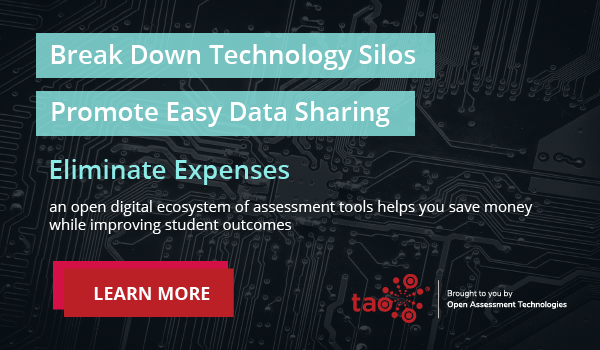In 2015, the Every Student Succeeds Act (ESSA) was signed into law in the United States as a replacement for No Child Left Behind (NCLB). The purpose of the ESSA is stated as follows: “to provide all children a significant opportunity to receive a fair, equitable, and high-quality education, and to close educational achievement gaps.” One of the biggest changes to federal policy enacted by ESSA was the shift in federal accountability to the states. This gave states the flexibility to develop accountability systems and measure student progress in new ways.
A cornerstone of ESSA is the flexibility for states to choose from a variety of national assessment measures to gauge achievement and growth. (Under NCLB states had to develop their own tests.) ESSA also provides an option for schools to use innovative assessment tools to develop tests that may not conform to traditional testing styles. This program is called the Innovative Assessment Pilot.
What is the Innovative Assessment Pilot?
The Innovative Assessment Pilot (IAP) is a component of the Every Student Succeeds Act (ESSA), which is a U.S. federal law that governs K-12 education policy. The IAP is a provision within ESSA that invites up to 7 U.S. states to experiment with innovative approaches to student assessment and accountability systems. The most recent data details that 5 states have been approved.
The main goal of the IAP is to encourage states to develop and implement new, innovative assessment methods that move beyond traditional standardized tests and better align with their student’s educational goals and needs. These innovative assessments aim to provide a more comprehensive and accurate picture of students’ knowledge, skills, and abilities, while also reducing the burden of high-stakes testing.
What kind of tests are used?
The specific types of assessments that may be used under this pilot program can vary from state to state, as states have the flexibility to design their own assessment systems, subject to federal approval. Here are some examples of innovative assessments that states may consider:
Performance-Based Assessments: These assessments require students to demonstrate their knowledge and skills through real-world tasks, projects, or simulations. For example, students might create a portfolio of their work or complete a project related to their coursework.
Competency-Based Assessments: These assessments focus on students’ mastery of specific skills or competencies rather than traditional grade levels. Students progress at their own pace and must demonstrate mastery before moving on to the next skill or topic.
Interim Assessments: These are assessments that are administered periodically throughout the school year to measure student progress and provide timely feedback to teachers and students. They can be designed to align with curriculum and instructional goals.
Adaptive Assessments: Adaptive assessments adjust the difficulty of questions based on a student’s responses. They are designed to provide a more accurate measure of a student’s abilities and can be used for personalized learning.
Digital Assessments: Many innovative assessments are delivered via digital platforms, which can provide interactive and multimedia-rich experiences that traditional paper-and-pencil tests cannot offer.
Performance Tasks: These are assessments that require students to apply their knowledge and skills to solve complex problems or complete extended tasks. They often involve critical thinking, analysis, and synthesis and may use innovative assessment tools.
Benefits and challenges
There are many benefits and challenges to developing and implementing new assessments via the Innovative Assessment Pilot. One of the benefits is that it gives states the flexibility to think outside of the box when assessing students. Traditional testing methods make it difficult to transition to new ways of thinking as new technology provides new learning opportunities. Having the ability to assess in new ways may produce more accurate student data using innovative assessment tools such as embedded adaptability.
Schools also hope that through the IAP, students and teachers may be able to receive more timely feedback. For many statewide tests, student feedback is processed over a few months. This means that it is constantly looking back at what a student could do instead of gauging where they are right now.
The challenges that come with designing a new assessment approach are many. In designing new assessments, states must ensure that what they come up with is equitable, measures student learning completely, can measure deep learning, and provides flexibility. However, the most significant challenge that state test creators and designers face is scalability. The assessment must be scalable at the state level for it to be considered for the federal program.
Requirements for Participating in the Pilot
To participate in the Innovative Assessment Pilot under the Every Student Succeeds Act (ESSA), states must meet certain requirements and follow specific guidelines set forth by the U.S. Department of Education:
Approval: States must submit a formal application to the U.S. Department of Education, outlining their plan for the innovative assessment system they wish to implement. This plan must meet the federal requirements and guidelines.
Compliance with ESSA: The proposed innovative assessment system must align with the requirements and principles of ESSA, including state academic content and achievement standards.
Annual Evaluation: States must commit to conducting an annual evaluation of the innovative assessment system’s validity, reliability, and comparability, as well as its impact on student achievement.
Consultation: States must engage in meaningful consultation with relevant stakeholders, including teachers, parents, and experts in the field of educational assessment.
Inclusion of All Students: The innovative assessment system must be designed to assess all students, including those with disabilities and Multilingual Learners (MLs), and provide appropriate accommodations as required by law.
Measuring Individual Student Growth: The assessment system must include measures of individual student academic growth over time, which can be used for accountability purposes.
Reporting Results: States must report the results of the innovative assessment to parents, educators, and the public clearly and understandably.
Timely Information: The assessment system must provide timely information about student achievement to inform instruction and support.
Continuity: States must ensure that their innovative assessment system provides continuity in reporting student achievement and school accountability over time.
Federal Approval: States must receive approval from the U.S. Department of Education for their innovative assessment plan. This approval process involves a review to ensure that the plan meets federal requirements and guidelines.
It’s important to note that while the Innovative Assessment Pilot allows for flexibility in assessment design, participating states must still maintain a strong commitment to academic rigor, equity, and accountability in education. States must also ensure that their innovative assessment system provides valid and reliable measures of student learning and growth.
Implications for Schools and Student Learning
Innovative assessment tools have the potential to provide a more accurate and comprehensive picture of student learning. They can measure a wider range of skills and competencies, including critical thinking, problem-solving, and real-world application of knowledge. Some innovative assessment approaches, such as competency-based assessments and adaptive assessments, can support personalized learning. Using innovative assessment tools, students can progress at their own pace and receive targeted feedback to address their specific needs.
These assessments may lead to enhanced engagement. Performance-based assessments and real-world tasks can engage students more deeply in their learning. These assessments often require students to apply their knowledge to practical situations, making learning more relevant and engaging. Additionally, many innovative assessments focus on skills that are increasingly important in the 21st century, such as critical thinking, creativity, collaboration, and communication.
Closing
Developing unique and effective assessments through IAP may allow states to assess students in a more timely manner and with more accuracy than more traditional testing methods. The goal of the IAP is to give states flexibility, equitably assess students, and provide timely results. In developing these tests technology will be front and center in the development and implementation of any standardized testing.
Using software platforms such as TAO, test creators and educators can develop and design assessments that meet the IAP guidelines and assess students using the latest in adaptive test technology and artificial intelligence. To learn more about how TAO can help you to assess students in your state, click here.


